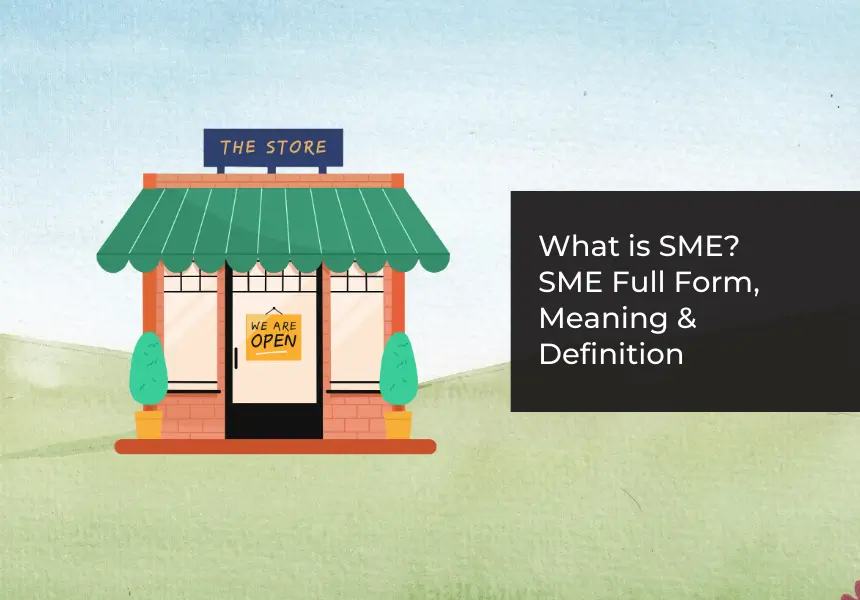
Did you know that India’s economy grows by 6-7% every year? A big part of this growth comes from SMEs. These businesses might not always make headlines, but they have a significant impact on the economy. They offer job opportunities to over 60 million people, create 1.3 million new jobs every year, and contribute 45% to India’s industrial output and 40% to its exports. With more than 9,000 products, SMEs help make India’s economy stronger and more diverse.
From small garages and grocery stores to local restaurants, SMEs come in all shapes and sizes. They are defined by their workforce, assets, and capital. But despite their importance, many of them struggle to get the finances they need because of limited resources.
To help them, the Indian government has introduced various programs. These include collateral-free loans, support for adopting new technologies, and help with expanding their business. Moreover, even NBFCs provide loans to SMEs, making it easier for them to grow and succeed.
So, what are SMEs, and why are they so important to India’s growth? Let’s find out.
SME Full Form & Meaning
SME stands for Small and Medium Sized Enterprises. Now, to answer the question, “What is SME?”- In India, SMEs are classified based on their investments across various sectors. Most of these businesses operate in the service and manufacturing sectors with a limited workforce and minimal investment in assets such as production plants, equipment, and manufacturing facilities, playing an important role in the country’s secondary, tertiary, and quaternary industries.
How are SMEs Classified?
Small and medium-sized enterprises (SMEs) can be categorized into three groups based on their investment in machinery and equipment, their turnover and the number of employees. Here’s a breakdown:
- Micro Enterprises: Micro enterprises are the smallest category of SMEs, characterized by their compact scale and limited resources. They have an investment limit of up to Rs. 1 Crore and a turnover limit of up to Rs. 5 Crore. They generally have employments of fewer than 10 people, these businesses are often owner-managed and focus on niche markets or specialized services, requiring minimal operational management systems.
- Small Enterprises: Small enterprises have an investment limit of up to Rs. 10 Crore and a turnover limit of up to Rs. 50 Crore. These companies employ 10 to 49 people, allowing for a more focused approach than larger businesses.
- Medium-sized Enterprises: Medium-sized enterprises are the largest category of SMEs. They have an investment limit of up to Rs. 20 Crore and a turnover limit of up to Rs. 100 Crore. With a workforce of 50 to 249 employees, they require less complex operational management systems compared to very large corporations.
What are the Types of SMEs?
SMEs operate in a variety of industries, each playing a unique role in driving progress. Below are some of the types of SMEs:
1. Manufacturing SMEs
These businesses produce goods like clothes, furniture, machinery, and electronic items. Manufacturing SMEs are important for industrial growth and often serve both local and international markets.
2. Service SMEs
Service-based MSMEs provide support to individuals and businesses. Examples include marketing agencies, IT services, consulting firms, and accounting services.
3. Trading SMEs
Trading MSMEs focus on buying and selling products. They work in both domestic and international markets, dealing with items like consumer goods, equipment, or raw materials.
4. Retail SMEs
These businesses sell products directly to consumers. They operate through physical stores or online platforms and include grocery shops, clothing stores, and electronic outlets.
5. Food and Beverage SMEs
This category includes businesses like restaurants, cafes, catering services, and food processing units. They are essential to the food and hospitality industry, catering to everyday needs.
6. Construction SMEs
Construction MSMEs work on projects like building houses, offices, or roads. They include contractors, electricians, plumbers, and other specialized workers who are important for infrastructure development.
What are the Benefits of SMEs?
SMEs are a source of growth, innovation, and community support. Investing in and encouraging SMEs benefits everyone in the long run. Some of the benefits of SMEs include:
1. Driving Economic Growth
SMEs play an important role in the growth of the economy. They contribute to the country’s GDP by increasing production, trade, and exports, making the economy stronger.
2. Creating Jobs
SMEs are great at providing job opportunities. They employ people in cities and rural areas, helping to reduce unemployment and improve the quality of life for many.
3. Supporting Entrepreneurs
Starting an SME is easier and requires less investment compared to big businesses. This encourages young and aspiring entrepreneurs to turn their ideas into reality, creating more jobs and opportunities in the process.
4. Encouraging Innovation
SMEs are known for their creativity and flexibility. They quickly adapt to changes and often come up with innovative solutions to meet market needs.
5. Enhancing Local Communities
SMEs operating in small towns and villages use local talent and resources. This supports regional development and helps improve the lives of people in those areas.
6. Expanding Global Reach
Many SMEs export their products and services, promoting local goods on an international level. This improves the country’s reputation and brings in valuable foreign income.
7. Strengthening the Economy
By working in different industries like manufacturing, services, and trading, SMEs reduce dependence on one sector. This diversification makes the economy more stable.
8. Promoting Inclusivity
SMEs provide opportunities to people with different skills. They help bridge income gaps and empower individuals by offering jobs and a chance to start businesses.
Government Initiatives and Support for SMEs
The Indian Government saw the potential of small and medium sized enterprises and launched several initiatives to support them in succeeding in a competitive environment. These programs aim to provide financial assistance, streamline processes, and promote growth through technology adoption and skill development. Some of these initiatives include:
1. Credit Guarantee Fund Scheme (CGFS)
This scheme helps SMEs access loans without the need for collateral. It provides credit guarantees, making it easier for businesses to secure the funds they need for operations or expansion.
2. Technology Upgradation Fund Scheme (TUFS)
Under TUFS, SMEs receive financial assistance to upgrade their technology and machinery. This helps businesses improve efficiency, productivity, and competitiveness in both domestic and international markets.
3. Pradhan Mantri Employment Generation Programme (PMEGP)
PMEGP encourages self-employment by providing financial support to individuals and small businesses. This program focuses on promoting entrepreneurship and creating more job opportunities.
4. Udyog Aadhaar Registration
This initiative eases the registration process for SMEs, making it quicker and more accessible. A streamlined registration process enables businesses to avail government benefits and schemes more efficiently.
5. MSME Sambandh
MSME Sambandh helps improve SMEs’ market access by connecting them with public sector undertakings (PSUs). This initiative helps small businesses secure contracts and expand their customer base.
6. Cluster Development Program (CDP)
The CDP focuses on growing industrial clusters by improving infrastructure, providing skill development opportunities, and fostering innovation. This program helps SMEs in specific industries grow collectively.
How to Apply for an SME Loan?
SME loans are business loans offered only to SMEs. They are customized to suit the needs and requirements of SMEs and, in most cases, don’t require collateral. While there are several government initiatives for SMEs, they can also opt for these loans to secure finances needed for several purposes, such as purchasing equipment, expanding operations, managing cash flow, or hiring staff. Here’s how you can apply for an SME loan:
1. Prepare the Required Documents
Start by gathering all necessary documents, such as your business registration certificate, proof of identity, financial statements, bank account details, and any other documents the lender may require. Having everything ready will make the process smoother.
2. Submit an Application
Visit the lender’s website, app, or office to begin your application. Provide basic details like your name, business information, annual turnover, and contact information. Some lenders may also ask for information about your business operations and future plans.
3. Complete the KYC Process
You will need to complete the KYC process. This generally includes submitting your PAN card, Aadhaar card, or other government-issued identification documents. To avoid delays, you must ensure that all the information is accurate.
4. Verification Process
Once you submit your application and upload the required documents, the lender will verify your information. This may involve checking your credit score, business performance, and financial stability to ensure you meet their eligibility criteria.
5. Approval and Loan Agreement
If your application is approved, you will receive the loan offer along with the terms and conditions. You should review the agreement carefully and understand all aspects, including the interest rate, repayment schedule, and any additional charges.
6. Loan Disbursement
After signing the loan agreement, the funds will be disbursed directly to your bank account. Depending on the lender, this process may take anywhere from a few hours to a couple of days.
Conclusion
Small and medium-sized enterprises play an important role in the country’s progress, driving innovation, job creation and economic growth.
While government initiatives provide valuable support to SMEs, the reality is that many businesses require additional financial resources to overcome challenges and capitalize on opportunities. For such additional support, MSME loans provide the capital necessary for growth and improving cash flow. These loans are offered at affordable interest rates and flexible repayment terms, facilitating business expansion, technological upgrades, and working capital management, all while enhancing credit profiles and enabling access to government schemes.
At LoanTap, we understand the unique needs of SMEs and the dedication it takes to grow and succeed. Our MSME loans come with an easy online application, minimum document requirement, flexible repayment terms, fast disbursal and competitive interest rates to provide the extra support you need.
Frequently Asked Questions
What are some challenges faced by SMEs?
SMEs usually face financing and technical challenges, which can be mostly solved through unsecured MSME loans from reputable lenders.
How do you qualify for an SME loan?
To qualify for an SME loan, you must be an Indian citizen between the ages of 23 and 65 and have a business experience of at least two years. However, this benchmark may vary across lenders. The following are eligible for an SME: self-employed professionals, entities like sole LLPs, partnership firms, trusts and proprietors.
What are the criteria for SME registration?
While an individual cannot apply for an SME registration, a proprietorship, partnership firm, company, trust, or society with an investment below Rs. 50 crore and annual turnover below Rs. 250 crore is eligible.
What is an SME example?
An SME example could be hair and beauty salons, dental practices, and medical centers.
Can an SME transition into a large corporation? If yes, how?
Yes, SMEs can scale up to become large corporations by expanding their product or service offerings, increasing market reach, and investing in infrastructure. Strategic planning, securing funding, building a strong customer base, improving operational efficiency, and adopting technology are essential for scaling. Gradual investments in marketing, team expansion, and automation can help the SME grow sustainably.








